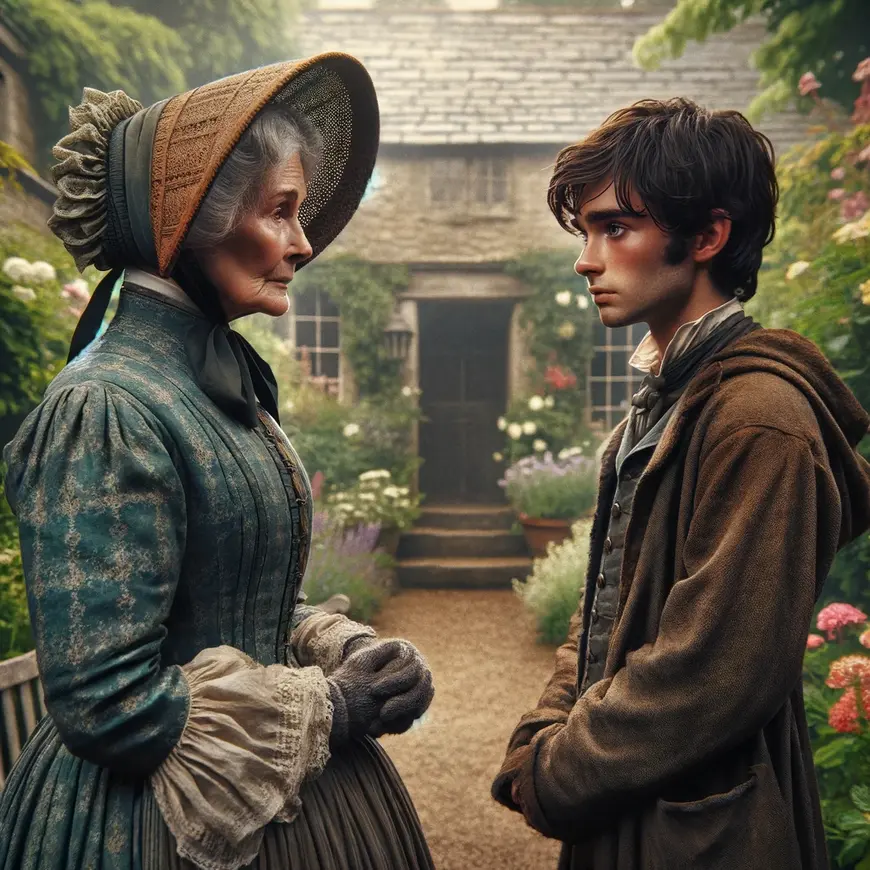Dickens’ Masterpiece Unveiled – A Heartfelt Journey through Life’s Twists and Turns in “David Copperfield”
Navigating Life’s Dickensian Maze – The Endearing Odyssey of “David Copperfield”
In the illustrious tapestry of classic literature, Charles Dickens‘ “David Copperfield” stands as a magnum opus, weaving a heartfelt narrative that traverses the convoluted pathways of life. With Dickensian flair and a touch of whimsy, the novel invites readers to join David Copperfield on a profound journey filled with love, loss, resilience, and the indomitable human spirit.
Unveiling the Dickensian Tapestry: The World of “David Copperfield”
Imagine a world where the pages of a young boy’s life mirror the ebbs and flows of the human experience. “David Copperfield” immerses us in this world, where we witness the protagonist’s evolution from an innocent child to a resilient adult, navigating the complexities of Victorian England. Dickens’ prose invites us to stroll through the cobblestone streets, visit the eccentric characters, and feel the heartbeat of an era that shaped David’s destiny.
The setting of “David Copperfield” is not merely a backdrop; it is a character in itself. Dickens’ vivid descriptions paint a detailed portrait of the places David encounters, from the idyllic Blunderstone Rookery to the gritty streets of London. The atmosphere he creates is both nostalgic and dynamic, reflecting the ever-changing landscape of David’s life.

Characters in the Spotlight: A Dickensian Panorama of Personalities
At the heart of “David Copperfield” is a rich ensemble of characters, each contributing to the vibrant tapestry of David’s life. From the affable Mr. Micawber to the enigmatic Uriah Heep, Dickens populates the narrative with a cast of characters as diverse and colorful as the pages of life itself. Each character becomes a vessel for readers to explore themes of friendship, betrayal, resilience, and the enduring power of the human spirit.
Themes of Love, Loss, Resilience, and Social Justice: Insights Explored
“Unraveling the Dickensian tapestry of love, loss, resilience, and social justice,” Dickens seems to say, as he delves into themes that echo across time and societal boundaries. The theme of love is central to the narrative, as David experiences the warmth of friendship, the bonds of family, and the complexities of romantic entanglements. Dickens’ exploration of love prompts readers to reflect on the transformative power of genuine connections and the myriad forms that love can take.
Loss, as an inevitable companion to life, is another prominent theme in “David Copperfield.” Dickens portrays David’s journey through the profound losses of loved ones, financial setbacks, and shattered illusions. The narrative encourages readers to contemplate the resilience of the human spirit in the face of adversity and the ways in which loss shapes and molds character.
Resilience, as a quality inherent in David’s character, is a recurring motif. Dickens traces David’s growth from a vulnerable orphan to a resilient adult who faces life’s challenges with determination and grace. The narrative prompts readers to consider the sources of inner strength and the transformative nature of adversity in shaping one’s character.
Social justice, reflecting Dickens’ keen awareness of societal issues, is woven into the fabric of “David Copperfield.” The novel addresses issues such as child labor, the plight of the working class, and the stark contrast between wealth and poverty in Victorian England. Dickens’ exploration of social justice prompts readers to reflect on the enduring relevance of these issues in contemporary society and the call for compassion and reform.
Prose as Dickensian Symphony: Dickens’ Writing Style
Charles Dickens’ writing style in “David Copperfield” is a Dickensian symphony, a harmonious blend of wit, humor, and poignant observation. His language is both accessible and eloquent, creating an atmosphere that is both immersive and emotionally resonant. Dickens’ prose is characterized by its vivid characterizations, its exploration of societal issues, and its ability to evoke a range of emotions, from laughter to tears.
The novel’s structure is meticulously crafted, with Dickens employing a first-person narrative that allows readers to intimately experience David’s thoughts, joys, and tribulations. Dickens’ writing style mirrors the rhythm of life itself, where moments of levity are juxtaposed with moments of profound introspection, creating a narrative that is both engaging and reflective.
Timeless Relevance: Dickens’ Masterpiece Unveiled
While “David Copperfield” is firmly rooted in its historical context, its exploration of love, loss, resilience, and social justice remains profoundly relevant in the contemporary world. In an era marked by the complexities of human relationships, the challenges of resilience in the face of adversity, and ongoing discussions of social justice, Dickens’ examination of these themes offers a timeless perspective.
The theme of love continues to resonate, as individuals navigate the intricacies of familial, platonic, and romantic relationships. “David Copperfield” prompts readers to reflect on the transformative power of love, the enduring nature of genuine connections, and the myriad forms that love can take in our lives.
Loss, as an inherent aspect of the human experience, remains a universal theme. The narrative encourages readers to contemplate the ways in which loss shapes and molds character, fostering resilience and personal growth in the face of life’s challenges.
Resilience, as a quality essential to the human spirit, is a theme that transcends time. “David Copperfield” prompts readers to consider the sources of inner strength, the transformative nature of adversity, and the ways in which resilience enables individuals to navigate the twists and turns of life.
Social justice, reflecting Dickens’ advocacy for societal reform, remains an urgent and timeless theme. The novel prompts readers to reflect on issues of economic inequality, the plight of marginalized communities, and the ongoing call for compassion and justice in contemporary society.

Famous Quotes from “David Copperfield” by Charles Dickens
- “Whether I shall turn out to be the hero of my own life, or whether that station will be held by anybody else, these pages must show.”
- Explanation: This is the opening line of the book. David wonders if he will be in control of his own destiny or if others will shape his life.
- “Never do tomorrow what you can do today. Procrastination is the thief of time.”
- Explanation: Mr. Micawber, a character in the book, advises against delaying tasks. Doing things promptly is important to avoid wasting time.
- “My meaning simply is, that whatever I have tried to do in life, I have tried with all my heart to do well; that whatever I have devoted myself to, I have devoted myself completely; that in great aims and in small, I have always been thoroughly in earnest.”
- Explanation: David expresses his dedication and earnestness in all his endeavors, whether big or small.
- “Accidents will occur in the best regulated families.”
- Explanation: This quote suggests that no matter how well things are managed, unexpected problems can still happen.
- “Trifles make the sum of life.”
- Explanation: This means that small, seemingly insignificant details and moments are what collectively make up a person’s life.
- “Annual income twenty pounds, annual expenditure nineteen nineteen six, result happiness. Annual income twenty pounds, annual expenditure twenty pounds ought and six, result misery.”
- Explanation: Mr. Micawber highlights the importance of living within one’s means. Spending more than you earn leads to financial trouble and unhappiness.
- “There can be no disparity in marriage like unsuitability of mind and purpose.”
- Explanation: David believes that the greatest mismatch in marriage is when the partners’ thoughts and goals are not aligned.
- “It is a principle of human nature to hate those whom we have injured.”
- Explanation: This suggests that people often develop negative feelings towards those they have wronged, possibly out of guilt or discomfort.
- “You have been in every line I have ever read, since I first came here, the rough common boy whose poor heart you wounded even then.”
- Explanation: David speaks of how deeply someone has impacted his life, being a constant presence in his thoughts and experiences.
- “A loving heart is the truest wisdom.”
- Explanation: This quote emphasizes that having a kind and loving heart is the wisest way to live, suggesting that compassion and love are the greatest virtues.
Trivia Facts about “David Copperfield”
- Autobiographical Elements: “David Copperfield” is often considered semi-autobiographical. Charles Dickens drew heavily from his own life experiences, particularly his childhood and early adulthood.
- First-Person Narrative: It is the first of Dickens’ novels to be written entirely in the first-person narrative, providing an intimate look at the protagonist’s thoughts and feelings.
- Serialized Publication: Like many of Dickens’ works, “David Copperfield” was initially published in serial form, with monthly installments released from May 1849 to November 1850.
- Influential Characters: The novel introduced some of Dickens’ most memorable characters, including Uriah Heep, Mr. Micawber, and Betsey Trotwood, who have left a lasting impact on literature.
- Personal Favorite: Charles Dickens regarded “David Copperfield” as his “favorite child” among his works, often stating that he had a special affection for the novel.
- Themes of Growth: The novel explores themes of personal growth and development, following David from childhood to adulthood, highlighting his struggles and triumphs.
- Social Commentary: “David Copperfield” offers critical insights into Victorian society, addressing issues such as child labor, education, and the legal system.
- Famous Adaptations: The novel has been adapted into numerous films, television series, and stage productions, showcasing its enduring popularity and influence.
- Influence on Other Authors: Many writers, including Fyodor Dostoevsky and James Joyce, have cited “David Copperfield” as an inspiration for their own work.
- Dickens’ Writing Process: Dickens often wrote late into the night and would act out scenes and dialogue as he wrote, bringing his characters to life through his animated writing process.
- Real-Life Inspirations: Several characters in the novel are based on people Dickens knew in real life, such as Wilkins Micawber, who is believed to be inspired by Dickens’ father.
- Narrative Complexity: The novel is known for its intricate plot and interwoven subplots, which reflect Dickens’ masterful storytelling and ability to create a richly detailed narrative world.
- Publication Success: “David Copperfield” was a commercial success upon its release, cementing Dickens’ reputation as one of the leading authors of his time.
- Illustrations: The original serialized version featured illustrations by Hablot Knight Browne, also known as “Phiz,” who collaborated with Dickens on several of his works.
- Educational Impact: The novel is widely studied in literature courses around the world and is considered a classic of English literature, continuing to captivate readers with its timeless themes and vivid characters.
Final Thoughts: A Dickensian Chronicle of Life’s Journey
“David Copperfield” is a Dickensian chronicle that invites readers to embark on an endearing journey through the maze of life. Charles Dickens’ narrative is a testament to the enduring power of literature to illuminate the complexities of human relationships, to invite us into the vibrant world of David Copperfield, and to prompt us to reflect on the timeless themes of love, loss, resilience, and social justice. Dickens’ prose becomes a vessel through which readers can navigate the pages of life’s Dickensian maze, savoring the humor, embracing the pathos, and celebrating the indomitable human spirit that resonates through the ages. “David Copperfield” is a testament to the enduring relevance of themes that have captivated readers for generations, and it invites us to navigate life’s journey with both empathy and resilience.
More Reviews of Charles Dickens Works
Reviving Spirits: A Deep Dive into the Timeless Tale of “A Christmas Carol” by Charles Dickens My Summary of A…
“Great Expectations” by Charles Dickens: A Timeless Tale of Ambition, Identity, and Redemption Short summary: My thoughts on Great Expectations…
A Timeless Masterpiece of Resurrection and Redemption – A Review of Charles Dickens’ “A Tale of Two Cities” Dickens’s Literary…
“Nicholas Nickleby” by Charles Dickens – A Heartwarming Journey Through Dickensian Adventures In the realm of classic literature, where tales…
A Tale of Innocence and Experience: “Oliver Twist” by Charles Dickens “Oliver Twist” by British writer Charles Dickens isn’t just…




